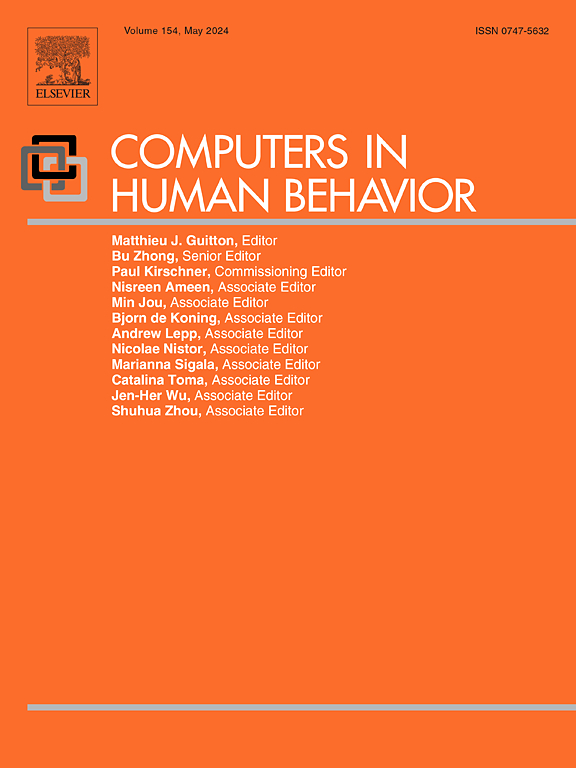Digital technology use and well-being in young children: A systematic review and meta-analysis
IF 9
1区 心理学
Q1 PSYCHOLOGY, EXPERIMENTAL
引用次数: 0
Abstract
As digital technology becomes increasingly integral to young children's lives, understanding its impact on psychosocial well-being is essential for guiding evidence-based recommendations for parents and policymakers. The current study provides a systematic review of the literature and meta-analysis of the relationship between digital technology use and psychosocial well-being in young children aged 4–6 years. A systematic search of eight databases was undertaken for studies published between January 2011 and February 2024. Studies reporting any quantitative measure of children's digital technology use (e.g., screentime, content, context, or specific device use - tablets, smartphones, computers, TV, gaming) and an indicator of psychosocial well-being (affect, behavioral difficulties, social functioning, and parent-child relationship quality) were included. After screening 3,554 records, 51 studies were included in the review (n = 83,862). The meta-analysis showed negative correlations between children's digital technology use and their overall psychosocial well-being (r = −.12, 95 % CI [-.24, −.00]), social functioning (r = −.06, 95 % CI [-.10, −.02]), behavioral functioning (r = −.10, 95 % CI [-.13, −.07]), and parent-child relationship quality (r = −.13, 95 % CI [-.20, −.06]). Of the few studies that measured technology use in ways other than duration (e.g., content, context), findings were mixed. While the negative relationship between amount of digital technology use and psychosocial well-being provides some support for recommendations to limit young children's digital technology use, a range of causal mechanisms should be considered. To understand whether these relationships vary dependent upon contextual factors of children's digital technology use, further research is required.

数字技术的使用与幼儿的幸福感:一项系统回顾和荟萃分析
随着数字技术日益成为幼儿生活的一部分,了解其对心理社会健康的影响对于指导家长和政策制定者提出基于证据的建议至关重要。目前的研究对文献进行了系统回顾,并对4-6岁幼儿的数字技术使用与心理社会健康之间的关系进行了荟萃分析。对2011年1月至2024年2月期间发表的研究进行了8个数据库的系统搜索。研究报告了儿童数字技术使用的任何定量测量(例如,屏幕时间、内容、环境或特定设备使用-平板电脑、智能手机、电脑、电视、游戏)和心理健康指标(影响、行为困难、社会功能和亲子关系质量)。在筛选了3554条记录后,51项研究被纳入本综述(n = 83862)。荟萃分析显示,儿童数字技术使用与他们的整体社会心理健康呈负相关(r = -)。12、95% ci[-]。24,−.00]),社会功能(r =−。[-] [j];10,−.02]),行为功能(r =−。10、95% ci[-]。13,−.07]),亲子关系质量(r =−。13、95% ci[-]。20日−06])。在少数以持续时间以外的方式(例如,内容、环境)衡量技术使用的研究中,结果好坏参半。虽然数字技术使用量与社会心理健康之间的负相关关系为限制幼儿使用数字技术的建议提供了一些支持,但应考虑一系列因果机制。要了解这些关系是否取决于儿童数字技术使用的背景因素,还需要进一步的研究。
本文章由计算机程序翻译,如有差异,请以英文原文为准。
求助全文
约1分钟内获得全文
求助全文
来源期刊

Computers in Human Behavior
Multiple-
CiteScore
19.10
自引率
4.00%
发文量
381
审稿时长
40 days
期刊介绍:
Computers in Human Behavior is a scholarly journal that explores the psychological aspects of computer use. It covers original theoretical works, research reports, literature reviews, and software and book reviews. The journal examines both the use of computers in psychology, psychiatry, and related fields, and the psychological impact of computer use on individuals, groups, and society. Articles discuss topics such as professional practice, training, research, human development, learning, cognition, personality, and social interactions. It focuses on human interactions with computers, considering the computer as a medium through which human behaviors are shaped and expressed. Professionals interested in the psychological aspects of computer use will find this journal valuable, even with limited knowledge of computers.
 求助内容:
求助内容: 应助结果提醒方式:
应助结果提醒方式:


